maintenance schedule Hyundai Matrix 2005 User Guide
[x] Cancel search | Manufacturer: HYUNDAI, Model Year: 2005, Model line: Matrix, Model: Hyundai Matrix 2005Pages: 407, PDF Size: 10.31 MB
Page 121 of 407

OWNER MAINTENANCE
6-14 G110A02E-EAT
AUTOMATIC TRANSAXLE FLUID
The automatic transaxle fluid level should be checked and changed at those intervals pre-scribed in the maintenance schedule. It is ofparamount importance that only the specifiedfluid is used when replenishing or changing thefluid. The use of other fluids may irreparablydamage the transaxle and invalidate the manu-facturers warranty. In addition the ingress of dirtor lint may prevent correct functioning of thetransaxle and care must be exercised to pre-vent the ingress of such matter. NOTE:
Automatic transaxle fluid is a red color. As driving distance increases, the fluid colorturns darkish red gradually. It is a normalcondition and you should not judge theneed to replace based upon the changingcolor.You must replace the automatic transaxlefluid in accordance with intervals specifiedin the vehicle maintenance schedule insection 5.
CAUTION:The transaxle on fluid level must bechecked with the engine running and atnormal operating temperature and there-fore care must be exercised to preventinjury occurring through contact withrotating or hot parts of the engine.
Ensure that the vehicle is parked on level
ground with the parking brake firmly appliedand the engine cool. Remove the level plugfrom the transaxle when lubricant should be-gin to drip from the level hole. If the level islow and no lubricant is seen to drip, add therequired quantity of lubricant and replace theplug.
SSA6100B
Transaxle Lubricant Level Checking
The manual transaxle lubricant must be checked and or changed at the intervalsspecified in the maintenance schedule. Onlythose lubricants specified should be used inorder to prevent gear shifting difficulties ortransaxle damage. WARNING: The transaxle lubricant level should only be checked when the engine is cold topreclude the possibility of personal injuryby contact with hot components.
Recommended Oil Use only the approved transaxle lubricant.The recommended lubricants are complete inthemselves and the use of additives is neitherrequired nor recommended. The use of addi-tives may invalidate the vehicle warranty.
SG100A1-E
MANUAL TRANSAXLE LUBRICANT
G110A01EDrain plug
Filler plug
Page 127 of 407
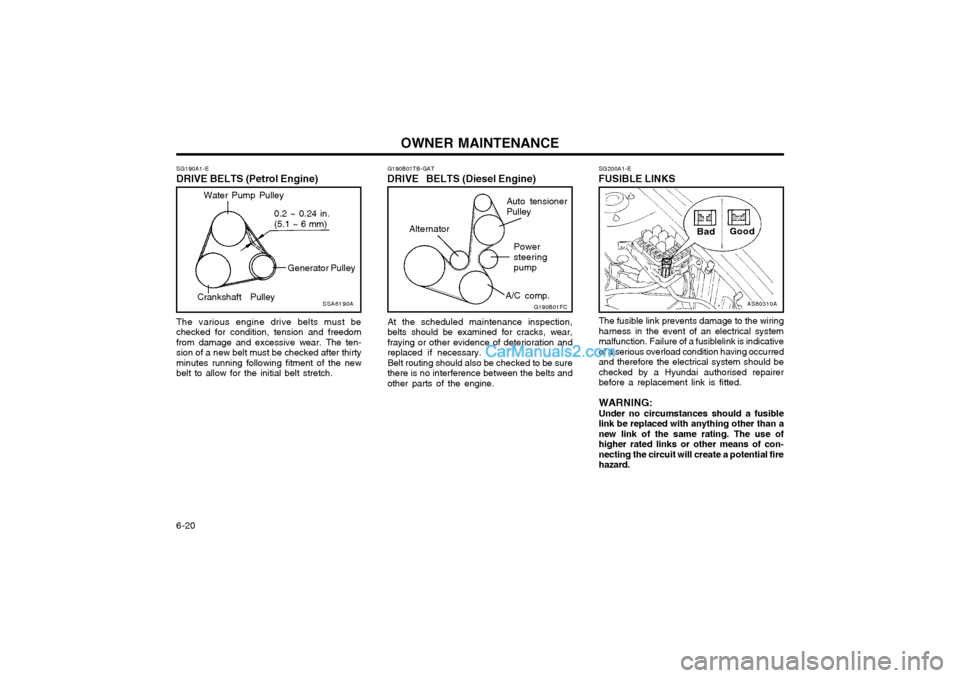
OWNER MAINTENANCE
6-20 SG200A1-E
FUSIBLE LINKS
AS60310A
Bad
Good
The fusible link prevents damage to the wiring harness in the event of an electrical systemmalfunction. Failure of a fusiblelink is indicativeof a serious overload condition having occurredand therefore the electrical system should bechecked by a Hyundai authorised repairerbefore a replacement link is fitted. WARNING: Under no circumstances should a fusible link be replaced with anything other than anew link of the same rating. The use ofhigher rated links or other means of con-necting the circuit will create a potential firehazard.
G190B01TB-GAT
DRIVE BELTS (Diesel Engine)
At the scheduled maintenance inspection,belts should be examined for cracks, wear,fraying or other evidence of deterioration andreplaced if necessary.Belt routing should also be checked to be surethere is no interference between the belts andother parts of the engine.G190B01FC
Auto tensioner Pulley Powersteeringpump
A/C comp.
Alternator
SG190A1-E
DRIVE BELTS (Petrol Engine)
SSA6190A
Water Pump Pulley
Generator Pulley
Crankshaft Pulley 0.2 ~ 0.24 in. (5.1 ~ 6 mm)
The various engine drive belts must be checked for condition, tension and freedomfrom damage and excessive wear. The ten-sion of a new belt must be checked after thirtyminutes running following fitment of the newbelt to allow for the initial belt stretch.
Page 139 of 407
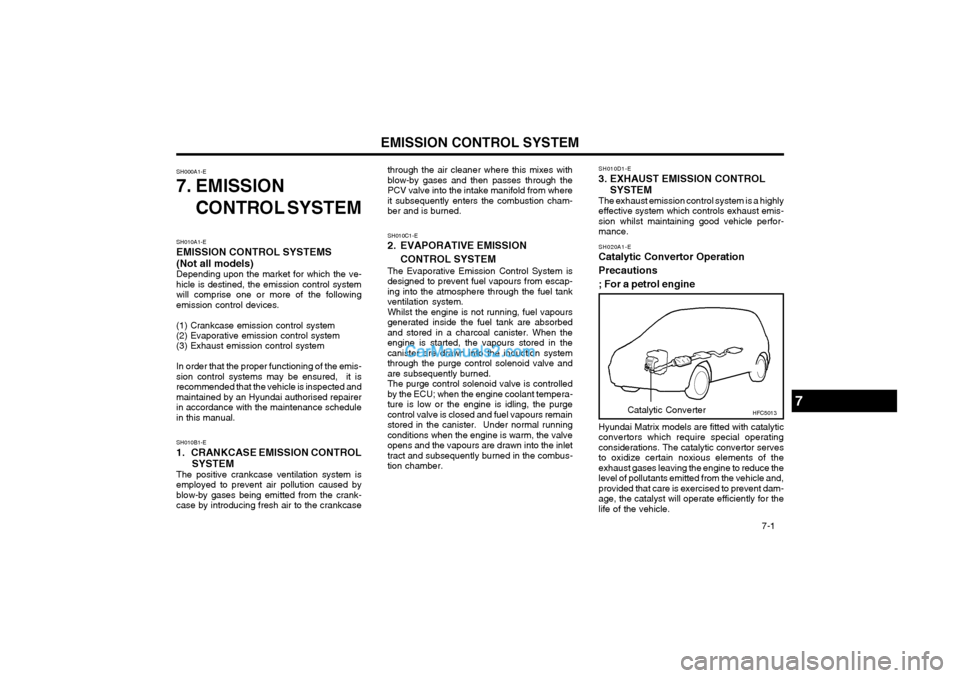
EMISSION CONTROL SYSTEM 7-1
SH000A1-E
7. EMISSION
CONTROL SYSTEM
SH010A1-E EMISSION CONTROL SYSTEMS (Not all models) Depending upon the market for which the ve-hicle is destined, the emission control systemwill comprise one or more of the followingemission control devices. (1) Crankcase emission control system (2) Evaporative emission control system (3) Exhaust emission control system In order that the proper functioning of the emis- sion control systems may be ensured, it isrecommended that the vehicle is inspected andmaintained by an Hyundai authorised repairerin accordance with the maintenance schedulein this manual. SH010B1-E 1. CRANKCASE EMISSION CONTROL SYSTEM
The positive crankcase ventilation system is employed to prevent air pollution caused byblow-by gases being emitted from the crank-case by introducing fresh air to the crankcase through the air cleaner where this mixes withblow-by gases and then passes through thePCV valve into the intake manifold from whereit subsequently enters the combustion cham-ber and is burned.
SH010D1-E 3. EXHAUST EMISSION CONTROL SYSTEM The exhaust emission control system is a highlyeffective system which controls exhaust emis-sion whilst maintaining good vehicle perfor-mance.
SH010C1-E
2. EVAPORATIVE EMISSION
CONTROL SYSTEM
The Evaporative Emission Control System is designed to prevent fuel vapours from escap-ing into the atmosphere through the fuel tankventilation system.Whilst the engine is not running, fuel vapoursgenerated inside the fuel tank are absorbedand stored in a charcoal canister. When theengine is started, the vapours stored in thecanister are drawn into the induction systemthrough the purge control solenoid valve andare subsequently burned.The purge control solenoid valve is controlledby the ECU; when the engine coolant tempera-ture is low or the engine is idling, the purgecontrol valve is closed and fuel vapours remainstored in the canister. Under normal runningconditions when the engine is warm, the valveopens and the vapours are drawn into the inlettract and subsequently burned in the combus-tion chamber. SH020A1-E
Catalytic Convertor Operation Precautions; For a petrol engine Hyundai Matrix models are fitted with catalytic convertors which require special operatingconsiderations. The catalytic convertor servesto oxidize certain noxious elements of theexhaust gases leaving the engine to reduce thelevel of pollutants emitted from the vehicle and,provided that care is exercised to prevent dam-age, the catalyst will operate efficiently for thelife of the vehicle.
7HFC5013
Catalytic Converter
Page 150 of 407
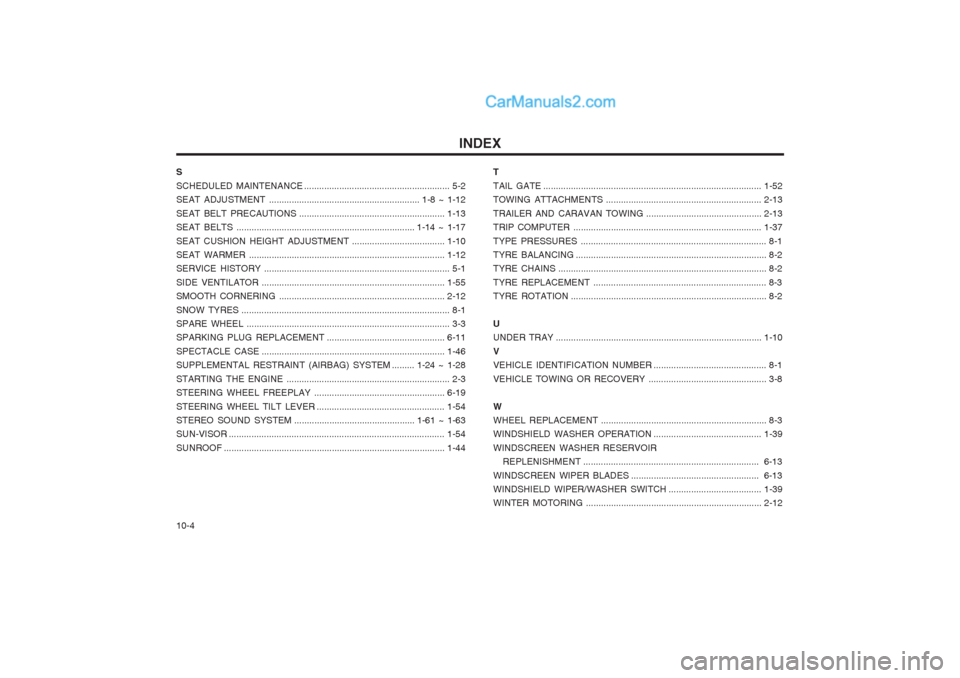
INDEX
10-4
S SCHEDULED MAINTENANCE
.......................................................... 5-2
SEAT ADJUSTMENT .. .......................................................... 1-8 ~ 1-12
SEAT BELT PRECAUTIONS .......................................................... 1-13
SEAT BELTS ....................................................................... 1-14 ~ 1-17
SEAT CUSHION HEIGHT ADJUSTMENT .....................................1-10
SEAT WARMER .............................................................................. 1-12
SERVICE HISTORY .......................................................................... 5-1
SIDE VENTILATOR ......................................................................... 1-55
SMOOTH CORNERING ............. .....................................................2-12
SNOW TYRES ................................................................................... 8-1
SPARE WHEEL ................................................................................. 3-3
SPARKING PLUG REPLACEMENT ...............................................6-11
SPECTACLE CASE ......................................................................... 1-46
SUPPLEMENTAL RESTRAINT (AIRBAG) SYSTEM ......... 1-24 ~ 1-28
STARTING THE ENGINE ................................................................. 2-3
STEERING WHEEL FREEPLAY ....................................................6-19
STEERING WHEEL TILT LEVER ...................................................1-54
STEREO SOUND SYSTEM ................................................ 1-61 ~ 1-63
SUN-VISOR ...................................................................................... 1-54
SUNROOF ........................................................................................ 1-44TTAIL GATE
....................................................................................... 1-52
TOWING ATTACHMENTS .............................................................. 2-13
TRAILER AND CARAVAN TOWING ..............................................2-13
TRIP COMPUTER ........................................................................... 1-37
TYPE PRESSURES .......................................................................... 8-1
TYRE BALANCING ............................................................................ 8-2
TYRE CHAINS ................................................................................... 8-2
TYRE REPLACEMENT ..................................................................... 8-3
TYRE ROTATION .............................................................................. 8-2
U UNDER TRAY .................................................................................. 1-10
VVEHICLE IDENTIFICATION NUMBER ............................................. 8-1
VEHICLE TOWING OR RECOVERY ............................................... 3-8
WWHEEL REPLACEMENT .................................................................. 8-3
WINDSHIELD WASHER OPERATION ...........................................1-39
WINDSCREEN WASHER RESERVOIR REPLENISHMENT ...................................................................... 6-13
WINDSCREEN WIPER BLADES ................................................... 6-13
WINDSHIELD WIPER/WASHER SWITCH .....................................1-39
WINTER MOTORING ...................................................................... 2-12
Page 300 of 407

2
DRIVING YOUR HYUNDAI
11
C090H01A-GAT NOTE:
o For smooth and safe operation, depress the brake pedal when shifting from "N"(Neutral) posi-tion or "P"(Park) position to a forward or "R"(Reverse) gear.
o The brake pedal fully depressed in order to move the shift leverfrom the "P" (Park) position to any of the other positions.
o It is always possible to shift from "R", "N", "D", "2", "L" position to"P" position. The vehicle mustbe fully stopped to avoid transaxle damage. C090I02A-AAT
CAUTION:
o Shift into "R" and "P" position only when the vehicle has com- pletely stopped.
o Do not accelerate the engine in reverse or any of the forwardpositions with the brakes applied.
o Always apply the footbrake when shifting from "P" or "N", to "R",
"D", "2" or "L" position.
o Do not use the "P" (Park) posi- tion in place of the parking brake.Always set the parking brake,shift the transaxle into "P" (Park) position and turn off the ignition when you leave the vehicle, evenmomentarily. Never leave the ve- hicle unattended while the en- gine is running.
o Check the automatic transaxle fluid level regularly, and add fluidas necessary.See the maintenance schedule for the proper fluid recommen- dation.
!
C090G01S-GAT o L (Low gear): Use for driving up a very steep grade or for engine braking when descendingsteep hills. When downshifting to "L", the transaxle will temporarily remain in second gear until the vehicle hasslowed enough for low gear to engage. Do not exceed 50 km/h (30 mph) in low gear."L" shifts to 1st gear only. However, shift up to 2nd is performed when the car exceeds a certain speed and, asspeed increases, the transaxle will shift up to 3rd gear to prevent over-revving the engine.
Page 306 of 407

2
DRIVING YOUR HYUNDAI
17
your foot resting on the brake pedal may cause the brakes to overheat,which reduces their effectiveness and may lead to more serious con- sequences.
o Take care of your tires. Keep them inflated to the recommended pres-sure. Incorrect inflation, either toomuch or too little, results in unnec- essary tire wear. Check the tire pres- sures at least once a month.
o Be sure that the wheels are aligned correctly. Improper alignment canresult from hitting curbs or drivingtoo fast over irregular surfaces. Poor alignment causes faster tire wear and may also result in other prob-lems as well as greater fuel con- sumption.
o Keep your car in good condition. For better fuel economy and reducedmaintenance costs, maintain your car in accordance with the mainte-nance schedule in Section 5. If you drive your car in severe conditions, more frequent maintenance is re-quired (see Section 5 for details). o Keep your car clean. For maximum
service, your Hyundai should bekept clean and free of corrosive materials. It is especially important that mud, dirt, ice, etc. not be al-lowed to accumulate on the under- side of the car. This extra weight can result in increased fuel con-sumption and also contribute to cor- rosion.
o Travel lightly. Don't carry unneces- sary weight in your car. Weight re-duces fuel economy.
o Don't let the engine idle longer than
necessary. If you are waiting (andnot in traffic), turn off your engine and restart only when you're readyto go.
o Remember, your Hyundai does not
require extended warm-up. As soonas the engine is running smoothly, you can drive away. In very cold weather, however, give your enginea slightly longer warm-up period. o Don't "lug" or "over-rev" the engine.
Lugging is driving too slowly in toohigh a gear resulting in the engine bucking. If this happens, shift to a lower gear. Over-revving is racingthe engine beyond its safe limit. This can be avoided by shifting at the recommended speeds.
o Use your air conditioning sparingly. The air conditioning system is oper-ated by engine power so your fueleconomy is reduced when you use it.
Page 307 of 407
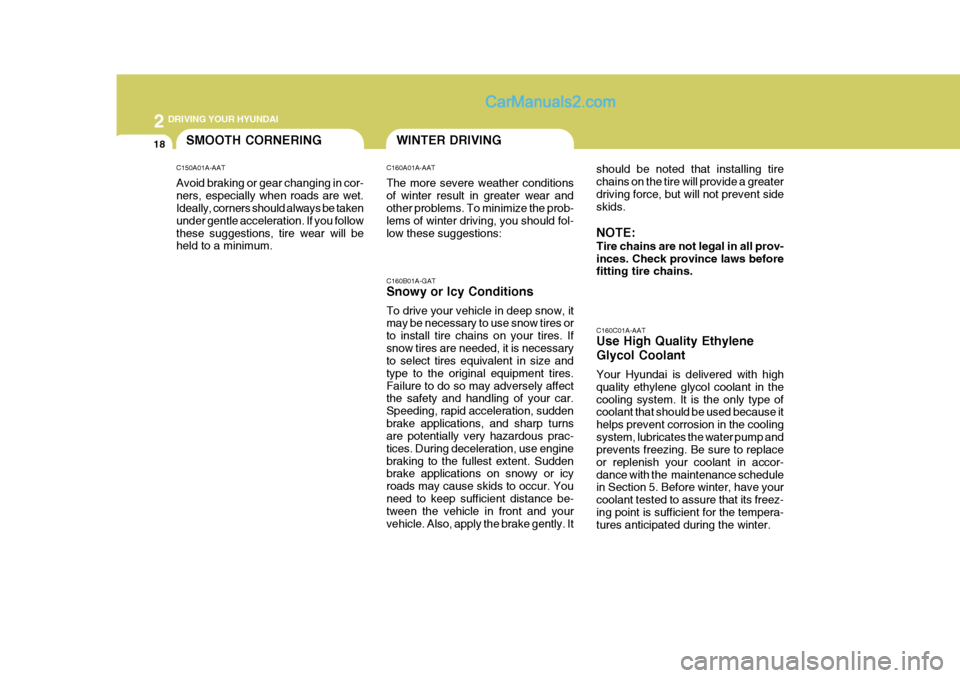
2 DRIVING YOUR HYUNDAI
18SMOOTH CORNERINGWINTER DRIVING
C160A01A-AAT The more severe weather conditions of winter result in greater wear and other problems. To minimize the prob- lems of winter driving, you should fol-low these suggestions:
C150A01A-AAT Avoid braking or gear changing in cor- ners, especially when roads are wet. Ideally, corners should always be taken under gentle acceleration. If you followthese suggestions, tire wear will be held to a minimum. should be noted that installing tire chains on the tire will provide a greaterdriving force, but will not prevent side skids. NOTE: Tire chains are not legal in all prov- inces. Check province laws before fitting tire chains.
C160B01A-GAT Snowy or Icy Conditions To drive your vehicle in deep snow, it may be necessary to use snow tires or to install tire chains on your tires. Ifsnow tires are needed, it is necessary to select tires equivalent in size and type to the original equipment tires.Failure to do so may adversely affect the safety and handling of your car. Speeding, rapid acceleration, suddenbrake applications, and sharp turns are potentially very hazardous prac- tices. During deceleration, use enginebraking to the fullest extent. Sudden brake applications on snowy or icy roads may cause skids to occur. Youneed to keep sufficient distance be- tween the vehicle in front and your vehicle. Also, apply the brake gently. It C160C01A-AAT Use High Quality Ethylene Glycol Coolant Your Hyundai is delivered with high quality ethylene glycol coolant in thecooling system. It is the only type of coolant that should be used because it helps prevent corrosion in the coolingsystem, lubricates the water pump and prevents freezing. Be sure to replace or replenish your coolant in accor-dance with the maintenance schedule in Section 5. Before winter, have your coolant tested to assure that its freez-ing point is sufficient for the tempera- tures anticipated during the winter.
Page 335 of 407
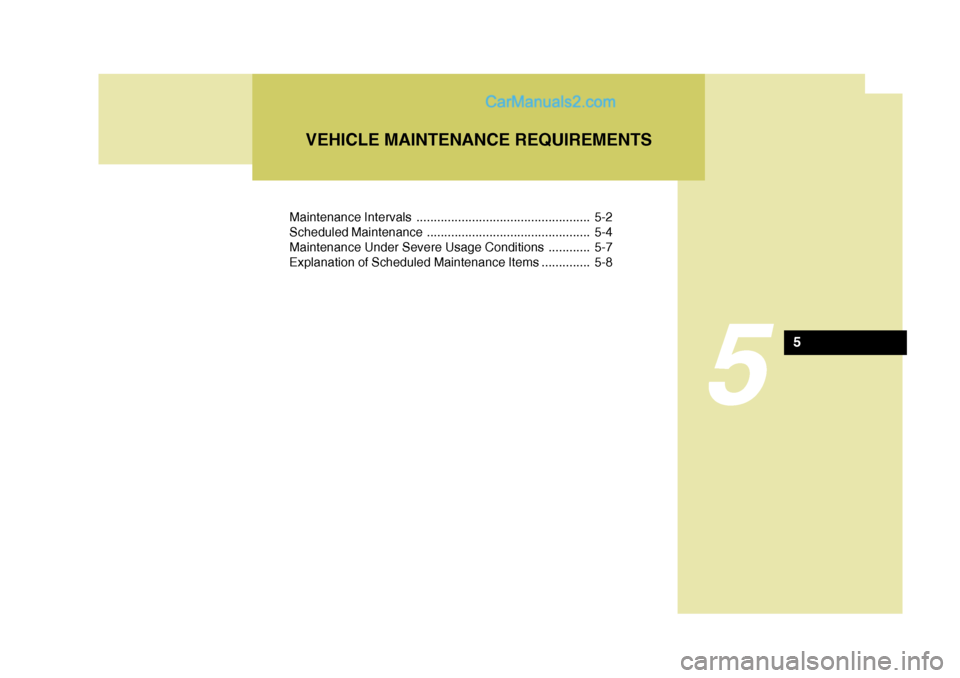
Maintenance Intervals .................................................. 5-2
Scheduled Maintenance ............................................... 5-4
Maintenance Under Severe Usage Conditions ............ 5-7
Explanation of Scheduled Maintenance Items .............. 5-8
5
VEHICLE MAINTENANCE REQUIREMENTS
5
Page 336 of 407
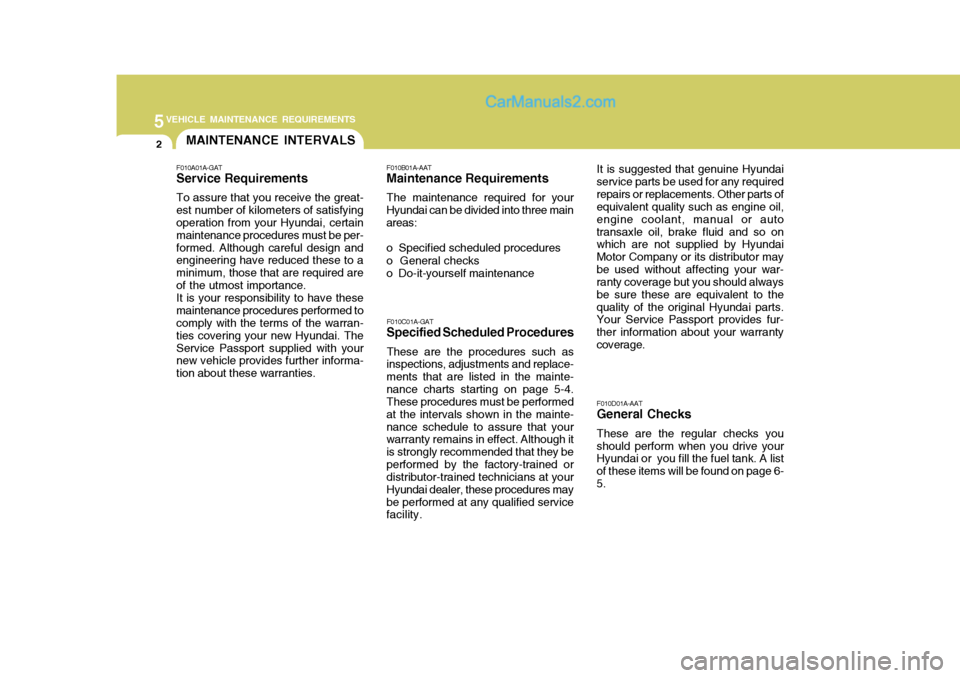
5VEHICLE MAINTENANCE REQUIREMENTS
2MAINTENANCE INTERVALS
F010C01A-GAT
Specified Scheduled Procedures
These are the procedures such as
inspections, adjustments and replace- ments that are listed in the mainte-nance charts starting on page 5-4. These procedures must be performed at the intervals shown in the mainte-nance schedule to assure that your warranty remains in effect. Although it is strongly recommended that they beperformed by the factory-trained or distributor-trained technicians at your Hyundai dealer, these procedures maybe performed at any qualified service facility. F010D01A-AAT
General Checks
These are the regular checks you should perform when you drive your Hyundai or you fill the fuel tank. A list of these items will be found on page 6-5.
F010A01A-GAT Service Requirements To assure that you receive the great- est number of kilometers of satisfying operation from your Hyundai, certain maintenance procedures must be per-formed. Although careful design and engineering have reduced these to a minimum, those that are required areof the utmost importance.It is your responsibility to have thesemaintenance procedures performed to comply with the terms of the warran- ties covering your new Hyundai. TheService Passport supplied with your new vehicle provides further informa- tion about these warranties.
F010B01A-AAT
Maintenance Requirements
The maintenance required for your
Hyundai can be divided into three main areas: o Specified scheduled procedures o General checks o Do-it-yourself maintenance It is suggested that genuine Hyundai
service parts be used for any requiredrepairs or replacements. Other parts of equivalent quality such as engine oil, engine coolant, manual or autotransaxle oil, brake fluid and so on which are not supplied by Hyundai Motor Company or its distributor maybe used without affecting your war- ranty coverage but you should always be sure these are equivalent to thequality of the original Hyundai parts. Your Service Passport provides fur- ther information about your warrantycoverage.
Page 337 of 407
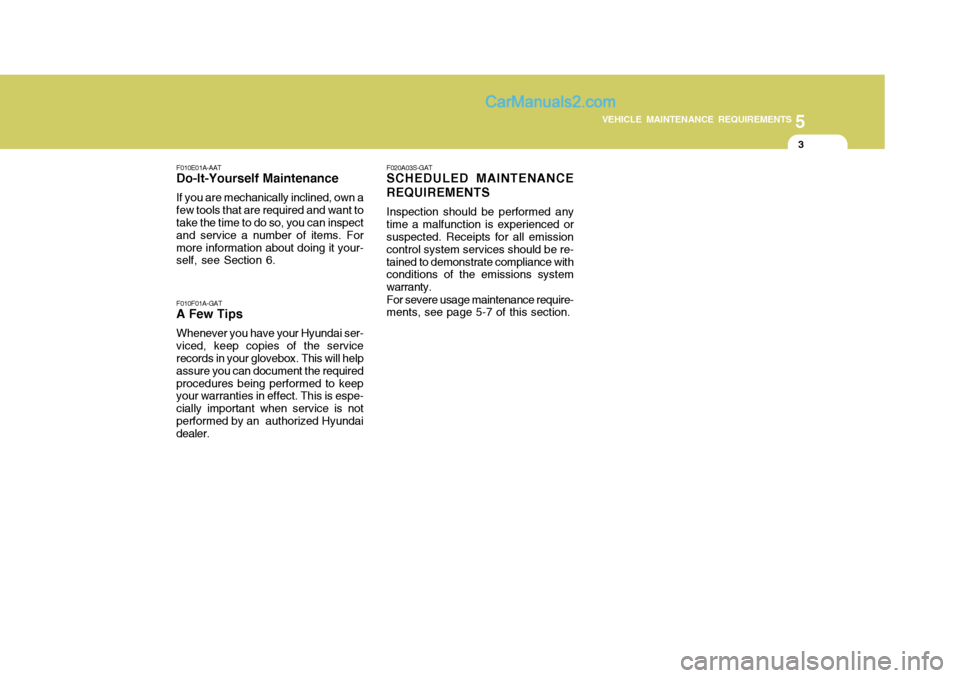
5
VEHICLE MAINTENANCE REQUIREMENTS
3
F010E01A-AAT
Do-It-Yourself Maintenance
If you are mechanically inclined, own a few tools that are required and want to take the time to do so, you can inspect and service a number of items. Formore information about doing it your- self, see Section 6. F010F01A-GAT
A Few Tips
Whenever you have your Hyundai ser- viced, keep copies of the service records in your glovebox. This will help assure you can document the requiredprocedures being performed to keep your warranties in effect. This is espe- cially important when service is notperformed by an authorized Hyundai dealer. F020A03S-GAT
SCHEDULED MAINTENANCE REQUIREMENTS
Inspection should be performed any time a malfunction is experienced or suspected. Receipts for all emission control system services should be re-tained to demonstrate compliance with conditions of the emissions system warranty. For severe usage maintenance require- ments, see page 5-7 of this section.